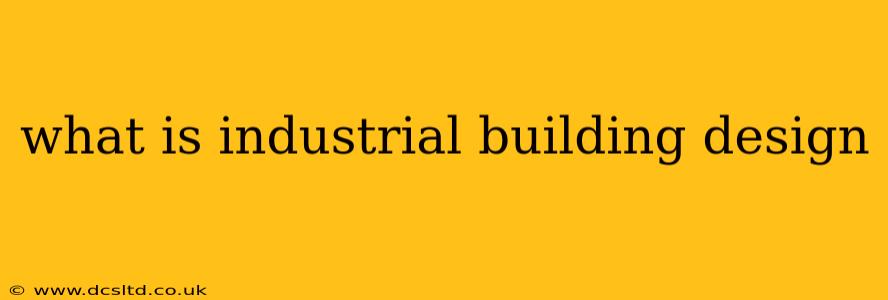Industrial building design encompasses the planning, engineering, and construction of structures specifically tailored for manufacturing, warehousing, distribution, and other industrial processes. Unlike residential or commercial architecture, industrial building design prioritizes functionality, efficiency, and durability above all else. This involves careful consideration of factors such as material handling, workflow optimization, environmental control, and safety regulations. It's a highly specialized field demanding a deep understanding of both architectural principles and industrial processes.
What are the key features of industrial building design?
Several key elements define effective industrial building design. These include:
-
High Bay Clearances: Industrial buildings often boast significant vertical space to accommodate large machinery, high-stacked storage, and overhead cranes. This is crucial for efficient material handling and maximizing usable space.
-
Heavy-Duty Construction: These structures must withstand heavy loads and potential impacts, necessitating robust construction using materials like reinforced concrete, steel, and specialized flooring systems.
-
Efficient Layout and Workflow: The design carefully optimizes the flow of materials and personnel throughout the building. This minimizes unnecessary movement, improves productivity, and reduces operational costs. This often involves strategic placement of loading docks, storage areas, and workspaces.
-
Robust Infrastructure: Industrial buildings require powerful electrical systems, extensive plumbing (potentially including specialized systems for industrial processes), and robust HVAC (Heating, Ventilation, and Air Conditioning) systems to maintain appropriate environmental conditions. Data and communication infrastructure are also critical components.
-
Safety Considerations: Safety is paramount. Industrial building design must incorporate features such as emergency exits, fire suppression systems, adequate lighting, and ergonomic considerations to minimize workplace hazards. Compliance with relevant safety regulations (OSHA in the US, for example) is essential.
-
Environmental Considerations: Increasingly, sustainable practices are integrated into industrial building design. This includes energy-efficient lighting and HVAC systems, the use of sustainable building materials, and strategies to minimize environmental impact.
What types of buildings are considered industrial?
The definition of "industrial building" is broad, encompassing a variety of structures:
-
Manufacturing Plants: Facilities where products are manufactured, often involving heavy machinery and complex processes.
-
Warehouses: Structures for storing goods, often large-scale operations with high ceilings and extensive racking systems.
-
Distribution Centers: Facilities optimized for receiving, sorting, and distributing goods efficiently.
-
Cold Storage Facilities: Warehouses designed to maintain specific temperature ranges for the storage of perishable goods.
-
Data Centers: Buildings housing computer systems and associated components, requiring robust power supplies and climate control.
What are the challenges of industrial building design?
Designing effective industrial buildings presents unique challenges:
-
Balancing Functionality and Cost: Meeting the specific needs of industrial processes while remaining within budget constraints can be difficult. Careful planning and material selection are crucial.
-
Adaptability to Future Needs: Industrial businesses often evolve, requiring buildings to adapt to changing processes and equipment. Flexibility in design is therefore crucial.
-
Meeting Regulatory Requirements: Adhering to various building codes, safety regulations, and environmental standards adds complexity to the design process.
-
Site Constraints: The availability of suitable land, access to utilities, and environmental considerations can significantly influence design decisions.
What are the trends in industrial building design?
The field of industrial building design is constantly evolving, driven by technological advancements and changing business needs:
-
Automation and Robotics: Designs are increasingly incorporating space and infrastructure for automated systems and robotics to improve efficiency and productivity.
-
Smart Building Technologies: Integration of smart sensors, data analytics, and IoT (Internet of Things) devices to monitor and optimize building performance.
-
Sustainability and Green Building Practices: A growing emphasis on environmentally friendly designs, reducing energy consumption, and minimizing environmental impact.
-
Modular and Prefabricated Construction: Using prefabricated components to speed up construction, reduce costs, and improve quality control.
In conclusion, industrial building design is a complex and dynamic field requiring specialized expertise. It's not just about creating a structure; it's about engineering an efficient, safe, and sustainable environment for industrial operations. The success of any industrial project hinges on careful planning, thorough understanding of the client's needs, and a keen eye for detail throughout the entire design and construction process.
